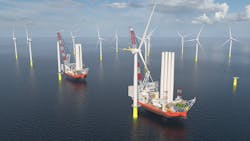Demand for specialized installation vessels has soared over the past year in response to the growth of the offshore wind energy market, as turbines get larger and project size increases in scale and scope. According to Westwood Global Energy Group, in Europe the average size of turbines currently under construction is 9.3 MW. However, 20-MW models are expected by the end of the decade.
Over the next few years, several wind turbine installation vessels (WTIV) will enter the market with greater carrying and lifting capacities and lower environmental footprints.
Recent orders
The increasing size of offshore wind turbines has sparked a wave of newbuild heavy-lift vessel orders.
Cadeler has commissioned COSCO Shipping Heavy Industry Co. Ltd. to construct two GustoMSC NG-20000X self-propelled wind turbine installation jackup vessels (Cadeler X-Class). The DNV-certified design features 5,600 sq m (60,278 sq ft) of deck space and a carrying capacity of more than 17,600 tons, which is said to be the industry’s largest. Each vessel should be able to transport and install seven complete 15-MW turbine sets or five sets of 20+ MW turbines. Other benefits of this arrangement are said to be faster installation speed, improving project economics while also cutting the carbon footprint of the process.
NOV, GustoMSC’s parent company, will also provide the jacking system that lifts the vessel and cargo above the waterline to install wind turbines. It incorporates proprietary regenerative power system technology that the company claims delivers fuel savings and emission reductions.
Huisman is supplying two >2,000-metric ton (2,205-ton) leg encircling cranes that will have a 155-m (509-ft) long boom, capable of reaching 180.5 m (592.2 ft) above deck. The vessels are expected to be delivered by 3Q 2024 and 1Q 2025.
Siemens Gamesa has chartered the first Cadeler X-Class vessel to transport and install 100 turbines for RWE’s 1.4-GW Sofia offshore wind park in the central North Sea. The 14-MW turbines are expected be the largest in the world at the time of installation. The turbines will be 252 m (827 ft) tall and have a rotor diameter of 222 m (728 ft).
Eneti Inc. has contracted Daewoo Shipbuilding and Marine Engineering in South Korea to build two NG-16000X jackup vessels. According to GustoMSC, the NG-16000X design provides for higher carrying and lifting capacities, and an increased lifting height above the deck. Also, the design provides the option to adapt the vessel to operate on alternate LNG or ammonia fuels in the future. The jackups are expected to be able to install up to 20-MW turbines in up to 65 m (213 ft) of water. Huisman is delivering two 2,600-metric ton (2,866-ton) leg encircling cranes that will have a 147-m (482-ft) long boom, capable of reaching 170 m (558 ft) above deck. The vessels are expected to be delivered in early 3Q 2024 and 2Q 2025.
Van Oord has hired Yantai CIMC Raffles in China to build a jackup vessel that can install up to 20-MW offshore wind turbines and foundations. Designed by Knud E Hansen, the 175-m (574-ft) long vessel will feature a Huisman crane that can lift more than 3,000 metric tons (3,306 tons).
According to Van Oord, the vessel will have an advanced jacking system. Four giant legs, each measuring 126 m (413 ft), will allow the vessel to be jacked up and work in waters up to 70 m (230 ft) deep. The vessel is expected to run on methanol, which will reduce the ship’s CO2 footprint by more than 78%, the company claimed. In addition, the vessel will be equipped with a selective catalytic reduction system to reduce the NOx emissions. Plus, a 5,000-kWh battery pack can take the peak loads and regenerate energy to reduce the fuel consumption (and corresponding emissions) even further.
It is expected to enter the market in 2024 and will work under the Dutch flag.
Under construction
From East Asia to the Texas Gulf Coast, construction is under way on many vessels that are designed to transport and install next-generation wind turbines and foundations.
Seaway 7 has two heavy-lift vessels under construction at the China Merchants Heavy Industry (CMHI) shipyard in Jiangsu, China. This year, the company should take delivery of the Alfa Lift, a semisubmersible installation vessel. Designed by Ulstein Design & Solutions B.V., the vessel will feature a 3,000-metric ton main crane, a 10,000-sq m (107,639-sq ft) deck that can carry and install up to 10 XL monopiles or eight jackets per voyage. It will also be able to fully submerge the main deck to a depth of 14.66 m (48 ft).
The Alfa Lift’s first assignment will be to transport and install the monopiles and transition pieces at the three-phase Dogger Bank wind farm in the UK North Sea.
Construction of the Seaway Ventus began last November. The GustoMSC NG-14000XL-G jackup vessel is expected to be able to operate in water depths of 65 m (213 ft), to a height of up to 182 m (597 ft) above the sea, and will feature a telescopic leg encircling crane with a maximum lifting capacity of 2,500 tons in retracted mode and 1,600 tons in extended mode.
Delivery is expected in mid-2023. The vessel’s first project will be to transport and install turbines at Ørsted’s Gode Wind 3 and Borkum Riffgrund 3 offshore wind farms in the German North Sea.
Meanwhile, Jan De Nul Group has two vessels under construction in China that are expected to be delivered this year. The CMHI Haimen shipyard is building the Les Alizés. This DP-2 heavy-lift vessel will feature a 5,000-metric ton (5,512-ton) capacity crane from Huisman, a deck loading capacity of 61,000 metric tons (67,241 tons), and a deck space of 9,300 sq m (100,104 sq ft).
According to the company, the Les Alizés will feature equipment that improve safety and efficiency in next-generation offshore wind installations. For instance, Huisman has developed a Universal Quick Connector, a clamp that attaches and detaches loads and tools directly to the crane’s lower block without rigging. Imeca is providing a motion-compensated pile gripper, with an integrated guidance and survey system, that it claims will allow safe and efficient installation of next-generation monopiles with pin-point accuracy. Plus, Remazel S.p.A. is supplying a fully automated monopile handling system that consists of a set of cradles, a skidding system, and an upending hinge that will handle and install XXL monopiles. It is said to be ideally suited to work in challenging weather conditions and high sea states.
The vessel’s first assignment is to transport and install 107 monopile foundations at Ørsted’s Gode Wind 3 and Borkum Riffgrund 3 projects.
The COSCO shipyard in Nantong is constructing the Voltaire, a jackup vessel that will feature a 3,000-metric ton capacity crane from Huisman. It is expected to debut at the Dogger Bank A and B wind farms in the UK North Sea.
The Les Alizés and Voltaire will be ultra-low emission vessels, Jan De Nul said.
Elsewhere, CSBC-DEME Wind Engineering (CDWE) is building Taiwan’s first floating DP-3 heavy-lift vessel in Kaohsiung. The Green Jade will feature a 4,000-metric ton (4,409-ton) capacity crane from Huisman and a waste heat recovery system that converts heat from the exhaust gases and cooling water to electrical energy. It will also have dual fuel engines and a Green Passport and Clean Design notation. Set to enter service in 2022, the 216.5-m (710-ft) long vessel will be deployed at the Hai Long and Zhong Neng offshore wind farms.
Finally, the first Jones Act-compliant WTIV is under construction at the Keppel AmFELS shipyard in Brownsville, Texas. Dominion Energy’s Charybdis is a GustoMSC NG-16000X-SJ jackup vessel that is designed to handle 12+ MW wind turbines.
The Charybdis’ hull is expected to have a length of 144 m (472 ft), a width of 56 m (184 ft) and a depth of 12 m (38 ft), which is said to make it one of the biggest vessels of its kind in the world. Huisman is providing the 2,200-metric ton (2,425-ton) leg encircling crane with a 130-m (426-ft) boom.
The vessel, which will be built to ABS Class, is scheduled to be delivered by the end of 2023.
Dominion Energy will use the Charybdis to install 176 14.7-MW turbines at its 2.6-GW Coastal Virginia Offshore Wind commercial project. This is the largest planned offshore wind farm in the US.
In addition, Ørsted and Eversource have chartered the Charybdis to support construction of the planned Sunrise Wind and Revolution Wind projects in the northeast US.
Fleet upgrades
Fred. Olsen Windcarrier (FOWIC), DEME, Cadeler, and Heerema Marine Contractors are upgrading cranes on their current vessels to meet future offshore heavy-lift demands.
FOWIC and DEME have ordered 1,600-metric ton (1,764-ton) cranes from Huisman for their jackup vessels Bold Tern and Brave Tern and the Sea Installer, respectively. The upgraded Sea Installer will be deployed for the first time at the 800-MW Vineyard Wind 1 project, 24 km (15 mi) offshore Martha’s Vineyard. The project will feature 62 GE Haliade-X 13-MW turbines that will have a 220-m (722-ft) rotor, 107-m (351-ft) blades, and be 248 m (814 ft) high.
Cadeler has ordered cranes from NOV for its jackup vessels Wind Orca and Wind Osprey. The new cranes will have a lifting capacity of 1,600 metric tons at a radius of 40 m (131 ft) and the main hook at 159 m (522 ft) above the main deck. The upgraded Wind Osprey is scheduled to install a minimum of 48 Siemens Gamesa 11-MW turbines at Gode Wind 3 and Borkum Riffgrund 3.
Meanwhile, Heerema has converted the Aegir from a deepwater construction to a heavy-lift vessel. It now has a 5,000-metric ton capacity crane, 2,000-metric ton second main hoist, 1,000-metric ton auxiliary hoist, and more deck space.





